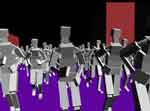A 3D computational model under development by an Arizona State University geographer incorporates patterns of human behaviour and movement and could be useful in helping city planners understand our conduct in crowded cities.
Clearly it’s impractical to conduct live experiments with hundreds or thousands of people along busy streetscapes, or to reproduce mob behaviour during riots for the purposes of academic experimentation!
So Paul M. Torrens, an assistant professor in the School of Geographical Sciences at the University, is developing a computer model that can be used to assist city planners, shopping centre developers, public safety and health officials, and researchers in exploring the dynamics of individual pedestrian and crowd behaviour in dense urban settings.
‘The idea is to use the model to test hypotheses, real world plans and strategies that are not very easy or are impossible to test in practice,’ Torrens said.
Current ways of measuring behaviour that use statistical analysis or physics models have not proven to have the veracity that this model could potentially have, according to Torrens.
The new modelling approach will incorporate individual behaviour and independent characteristics - age, sex, size, health, body language - while also taking into account crowd-level features such as panic, as well as characteristics of the environment, such as safety levels. The simulations will model both motion and emotion, Torrens said.
The model ‘will serve as an experimental, but wholly realistic, environment for exploring “what-if” and unforeseen scenarios of relevance to cities and their citizens,’ he added.
Torrens’s research will be aided by a National Science Foundation CAREER Award in the amount of $400,000 over five years. The award is the most prestigious award that the NSF grants to junior faculty. While highly sought after, the award is rarely given to geographers.
With the NSF grant Torrens plans to have hundreds of thousands of pedestrian agents and larger downtown areas within the model. ‘We can look quantitatively at the results of reconfiguring the urban environment, social environment, and ultimately, human behaviour, which is something you can never do in the real world,’ he said.

A still from an interactive model of crowd evacuation dynamics in a dense urban setting.




Poll: Should the UK’s railways be renationalised?
I think that a network inclusive of the vehicles on it would make sense. However it remains to be seen if there is any plan for it to be for the...